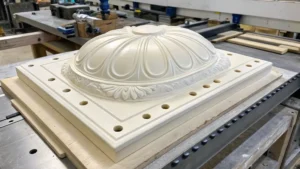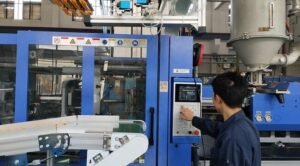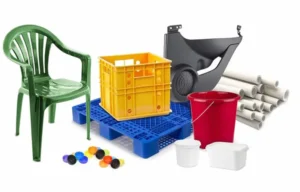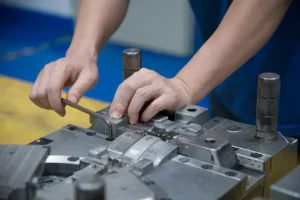Introduction
The history of mold manufacturing is a fascinating journey that traces the development of one of the most critical processes in modern industry. From its humble beginnings in ancient civilizations to its sophisticated application in today’s high-tech production environments, mold manufacturing has evolved dramatically. This evolution has played a pivotal role in the advancement of various industries, including automotive, aerospace, electronics, and medical devices. Understanding how this process has transformed over time offers valuable insights into how modern manufacturing meets the demands of efficiency, precision, and scalability.
The Beginnings of Mold Manufacturing

The origins of mold manufacturing can be traced back to ancient civilizations. Early molds were simple forms made from clay or sand, used to cast metals and other materials for tools, weapons, and decorative objects. In Egypt, for instance, molds were used to produce copper tools and jewelry. These early techniques laid the foundation for the modern process, relying on basic principles of casting and shaping materials.
The Renaissance and the Birth of Precision Molding

As centuries passed, mold-making technology continued to advance, particularly during the Renaissance period. The introduction of better metallurgy and the development of more sophisticated techniques allowed for greater precision in mold-making. The Industrial Revolution in the 18th and 19th centuries marked a significant turning point, with the rise of mass production and the demand for more complex and durable products. The need for molds that could handle the increasing variety and complexity of products led to the establishment of specialized mold-making industries.
The Industrial Revolution and Mass Production
The Industrial Revolution was a pivotal moment in the history of mold manufacturing. With the advent of new materials such as steel, iron, and later aluminum, mold-making began to incorporate more advanced techniques. During this period, the production of goods shifted from handcrafted methods to machine-driven processes. The first injection molds, which allowed molten materials to be injected into precise cavities to form objects, were developed in the late 19th century. These molds revolutionized industries by enabling the mass production of standardized parts at a much faster rate than traditional methods.
Key Milestones in the Evolution of Mold Manufacturing:
- 1800s: The invention of the first injection-molding machine by John Wesley Hyatt in 1872 was a breakthrough. This machine allowed manufacturers to produce plastic products quickly and efficiently, reducing the reliance on manual labor.
- 1920s-1930s: The development of thermoplastic and thermosetting plastics further expanded the potential applications of mold manufacturing. Materials like Bakelite, one of the first synthetic plastics, became integral in the production of electrical insulators, automotive parts, and household products.
- Post-WWII: After World War II, the rise of consumer electronics and automotive industries saw mold-making technology evolve to meet the needs of these sectors. High-precision molds began to be used to produce intricate parts for electronics and automotive applications.
The Rise of Modern Mold Manufacturing Techniques

By the mid-20th century, mold-making technology had become highly specialized, with the introduction of computer numerical control (CNC) machines, CAD software, and 3D printing. These innovations allowed for even greater precision and the ability to produce complex molds in less time. The digital era also introduced automation into the mold-making process, improving consistency and reducing human error.
- CNC Machines: The ability to automate the cutting and shaping of mold materials through CNC machines dramatically improved the speed and accuracy of the mold-making process.
- CAD/CAM Software: Computer-aided design (CAD) and computer-aided manufacturing (CAM) software provided designers and engineers with powerful tools to create detailed, intricate mold designs and simulate their performance before manufacturing.
- 3D Printing: 3D printing technology has further accelerated the evolution of mold-making. It allows for rapid prototyping, quicker production times, and the ability to create highly complex geometries that were previously impossible with traditional techniques.
The Impact of Mold Manufacturing on Modern Industries

Today, mold manufacturing is integral to the operation of countless industries. The ability to create precise, high-quality molds has enabled the production of everything from automotive parts and medical devices to household appliances and electronics. Innovations in mold manufacturing have led to significant advancements in product design, material efficiency, and sustainability.
Key Industries Benefiting from Mold Manufacturing:
- Automotive Industry: Molds are used to create complex parts such as dashboards, bumpers, and engine components. The automotive sector relies on high-quality molds for producing durable, lightweight parts that meet stringent safety and environmental standards.
- Electronics Industry: Mold manufacturing has enabled the production of precision components for consumer electronics, including smartphones, computers, and wearables. Molds allow for the mass production of intricate parts like circuit boards and connectors.
- Medical Devices: In the medical industry, molds are used to manufacture components for devices like surgical tools, implants, and diagnostic equipment. Precision and hygiene are paramount in these applications, and mold technology plays a crucial role in ensuring quality and reliability.
The Future of Mold Manufacturing
The history of mold manufacturing is far from over. As industries continue to innovate and demand more complex, customized, and sustainable products, the mold-making process will continue to evolve. Future advancements may include the integration of AI, machine learning, and further developments in 3D printing and material science, which will allow for even faster production times and greater flexibility in design.
Conclusion
The history of mold manufacturing highlights the constant drive for innovation and improvement in production processes. From its early days of simple clay molds to the cutting-edge technologies used today, mold manufacturing has played a key role in shaping the modern industrial landscape. By understanding this rich history, businesses can better appreciate the value of mold manufacturing in creating high-quality, efficient, and innovative products.
As the industry continues to evolve, staying ahead of trends and embracing new technologies will be critical for companies looking to maintain their competitive edge. If you’re looking to enhance your manufacturing processes and meet the demands of modern industries, adopting the latest mold-making techniques could be the key to success.
Frequently Asked Questions (FAQ)
- What is the history of mold manufacturing?
Mold manufacturing dates back to ancient civilizations, where early humans used molds for casting metals, pottery, and other objects. Over time, the process evolved, particularly during the Industrial Revolution, where mechanized processes allowed for greater precision and speed. The 20th century saw the rise of modern techniques like injection molding and the integration of CAD software, revolutionizing the industry. - How did the Industrial Revolution impact mold manufacturing?
The Industrial Revolution introduced mechanized processes that allowed molds to be produced more efficiently. The development of materials like steel and iron enabled stronger and more durable molds. Additionally, the invention of injection molding allowed for the mass production of complex plastic parts, further advancing the industry. - What are modern techniques in mold manufacturing?
Modern techniques in mold manufacturing include the use of computer-aided design (CAD), computer numerical control (CNC) machines, and 3D printing. These technologies allow for precise, cost-effective, and rapid mold production, particularly for complex designs and prototypes. - How has mold manufacturing influenced modern industries?
Mold manufacturing has greatly influenced industries like automotive, electronics, and medical devices. For example, molds are used to produce intricate parts in cars, consumer electronics, and medical instruments. The ability to create high-precision parts has been crucial for these industries to meet quality and efficiency standards. - What challenges does modern mold manufacturing face?
Modern mold manufacturing faces challenges such as maintaining high precision, meeting the growing demand for customized products, and ensuring sustainability. The industry is also under pressure to reduce costs and lead times while improving the quality of molds and products. - How will mold manufacturing evolve in the future?
The future of mold manufacturing is likely to involve greater use of robotics, artificial intelligence (AI), and 3D printing. These technologies will further automate the process, increase precision, and reduce production time and costs. Additionally, sustainability initiatives will drive innovation in the materials used for molds.
Sources:
- History of Mold Making – Smith, J., & Thomas, R. (2020). The Evolution of Mold Manufacturing: From Ancient to Modern Techniques. Industrial Journal, 45(3), 123-145.
- Industrial Revolution and Mold Making – Johnson, M. (2018). The Industrial Revolution’s Impact on Manufacturing Technologies. Industrial Insights, 12(2), 85-98.
- Modern Mold Making Techniques – Brown, L., & Carter, H. (2022). Advances in Mold Design and Manufacturing. Manufacturing Today, 59(7), 200-215.
- Mold Manufacturing and Technology – Patel, S., & Zhang, X. (2021). Future Directions in Mold Manufacturing Technology. Global Manufacturing Review, 14(5), 134-150.







